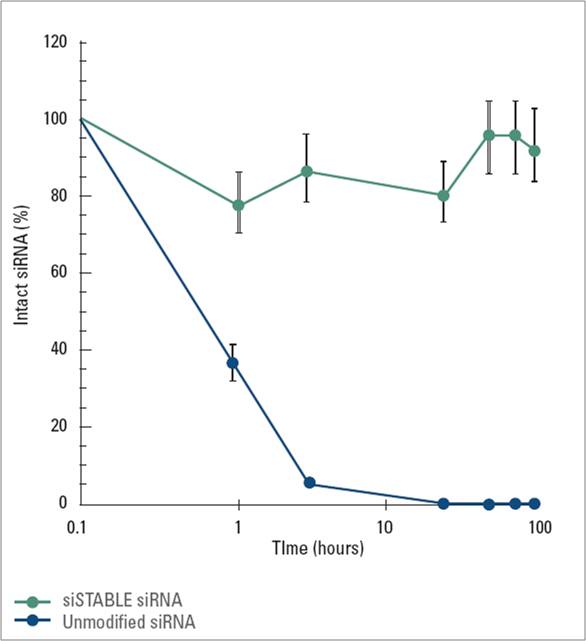siSTABLE Non-targeting siRNA #1

siSTABLE Non-Targeting siRNA #1 was designed to have a minimum of four mismatches to all human, mouse, and rat genes to avoid non-specific silencing due to off-targets. This negative control siRNA is chemically modified to significantly extend siRNA stability an is recommended for use as a negative control in experiments using siSTABLE modified siRNA against a target gene or where increased stability of the control is desired.
Highlights
- BLAST analysis confirms at least 4 mismatches with all known human, mouse, and rat genes
- Chemically modified to significantly extend siRNA stability
- Recommended for use as a non-specific control in experiments using siSTABLE modified siRNA against the target gene or where increased stability of the control is desired
Experimental considerations
siRNA-mediated RNAi experiments should include non-targeting siRNA as a control for non-sequence-specific effects. Changes in mRNA or protein levels in cells or tissues treated with these controls reflect a non-specific baseline cellular response to which the levels in cells or tissues treated with target-specific siRNA can be compared.
To request a larger quantity or in vivo processing of this control product, please contact Scientific Support.
Stability of siSTABLE siRNA in 100% Human Serum

The siSTABLE modification pattern dramatically extends the half-life of siRNA in the presence of 100% human serum. Unmodified siRNA degrades almost immediately while siSTABLE siRNA maintains integrity for up to 5 days.
- S. Cabodi et al., p130Cas is an essential transducer element in ErbB2 transformation. FASEB J. 24(10), 3796-3808 (October 2010).
- N. C. Henderson et al., Galectin-3 regulates myofibroblast activation and hepatic fibrosis. PNAS. 103(13), 5060-5065 (28 March 2006).
- K. Hocherl et al., Inhibition of NF-kB ameliorates sepsis-induced downregulation of aquaporin-2/V 2 receptor expression and acute renal failure in vivo. Am J Physiol Renal Physiol. 298(1), F196-F204 (January 2010).
- S. D. Larson et al., Effectiveness of siRNA uptake in target tissues by various delivery methods. Surgery. 142(2), 262-269 (August 2007).
- M. Snapyan et al., Vasculature guides migrating neuronal precursors in the adult mammalian forebrain via brain-derived neurotrophic factor signaling. J. Neurosci. 29(13), 4172-4188 (1 April 2009).
- S. Van de Veire et al., Further pharmacological and genetic evidence for the efficacy of PIGF inhibition in cancer and eye disease. Cell. 141(1), 178-190 (2 April 2010).
- J. C. Wang et al., Attenuation of fibrosis in vitro and in vivo with SPARC siRNA. Arthritis Res & Therapy. 12(2), R60 (2010).
- B. Yang et al., MAGE-A, mMage-b, and MAGE-C proteins form complexes with KAP1 and suppress p53-dependent apoptosis in MAGE-positive cell lines. Cancer Res. 67(20), 9954-9962 (15 October 2007).
- D. Bartlett, M. Davis, Insights into the kinetics of siRNA-mediated gene silencing from live-cell and liveanimal bioluminescent imaging. Nucleic Acids Res. 34(1), 322-333 (12 January 2006).
- J. M. Li et al., Local arterial nanoparticle delivery of siRNA for NOX2 knockdown to prevent restenosis in an atherosclerotic rat model. Gene Therapy. 17(10), 1279-1287 (October 2010).
- B. Maier et al., The unique hypusine modification of eIF5A promotes islet B cell inflammation and dysfunction in mice. J Clin Invest. 120(6), 2156-2170 (June 2010). [doi: 10.1172/JCI38924]
- N. Mambetsariev et al., Hyaluronic acid binding protein 2 is a novel regulator of vascular integrity. Arterioscler Thromb Vasc Biol. 30(3), 483-490 (March 2010).
- T. Mirzapoiazova et al., The non muscle myosin light chain kinase isoform is a viable molecular target in acute inflammatory lung injury. Am J Respir Cell Mol Biol. 44(1), 40-52 (2011).
- R. Natarajan et al., Activation of hypoxia-inducible factor-1 via prolyl-4 hydoxylase-2 gene silencing attenuates acute inflammatory responses in postischemic myocardium. Am J Physiol Heart Circ Physiol. 293(3), h2571-h2580 (September 2007).
- K. Niizuma et al., The PIDDosome mediates delayed death of hippocampal CA1 neurons after transient global cerebral ischemia in rats. PNAS. 105(42), 16368-16373 (2008).
- S. W. Park et al., Sphinganine-1 phosphate protects kidney and liver after hepatic ischemia and reperfusion in mice through S1P1 receptor activation. Lab Invest. 90(8), 1209-1224 (August 2010).
- M. Peters et al., RNA interference in hippocampus demonstrates opposing roles for CREB and PP1a in contextual and temporal long-term memory. Genes, Brain, and Behavior. 8(3), 320-329 (April 2009).
- C. Schmidt et al., Role of nuclear factor-kappaB-dependent induction of cytokines in the regulation of vasopressin V1A-receptors during cecal ligation and puncture-induced circulatory failure. Crit Care Med. 36(8), 2363-2372 (August 2008).
- P. Singleton et al., High-moleculer-weight hyaluronan is a novel inhibitor of pulmonary vascular leakiness. Am J Physiol Lung Cell Mol Physiol. 299, L639-L651 (2010).
Safety data sheets
Related Products
Molecular grade water for dilution of 5x siRNA Buffer or resuspension of RNA. RNase-free to prevent degradation of RNA reagents and oligonucleotides.
Catalog ID:B-003000-WB-100
Unit Size:100 mL
